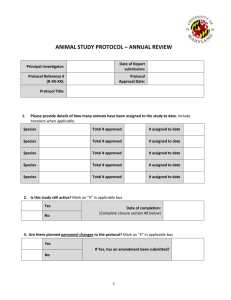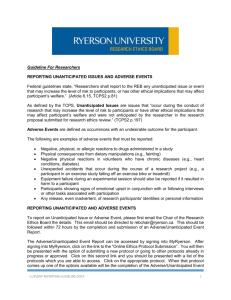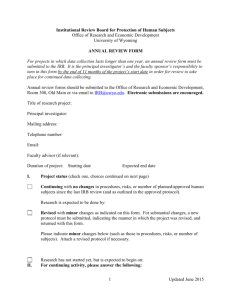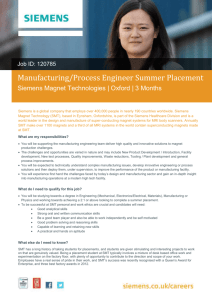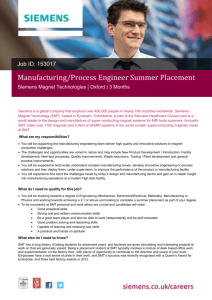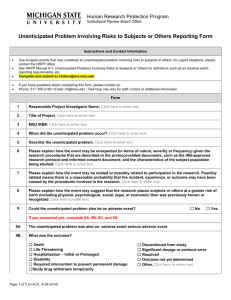SITUATION MANAGEMENT TEAM CHARTER
advertisement
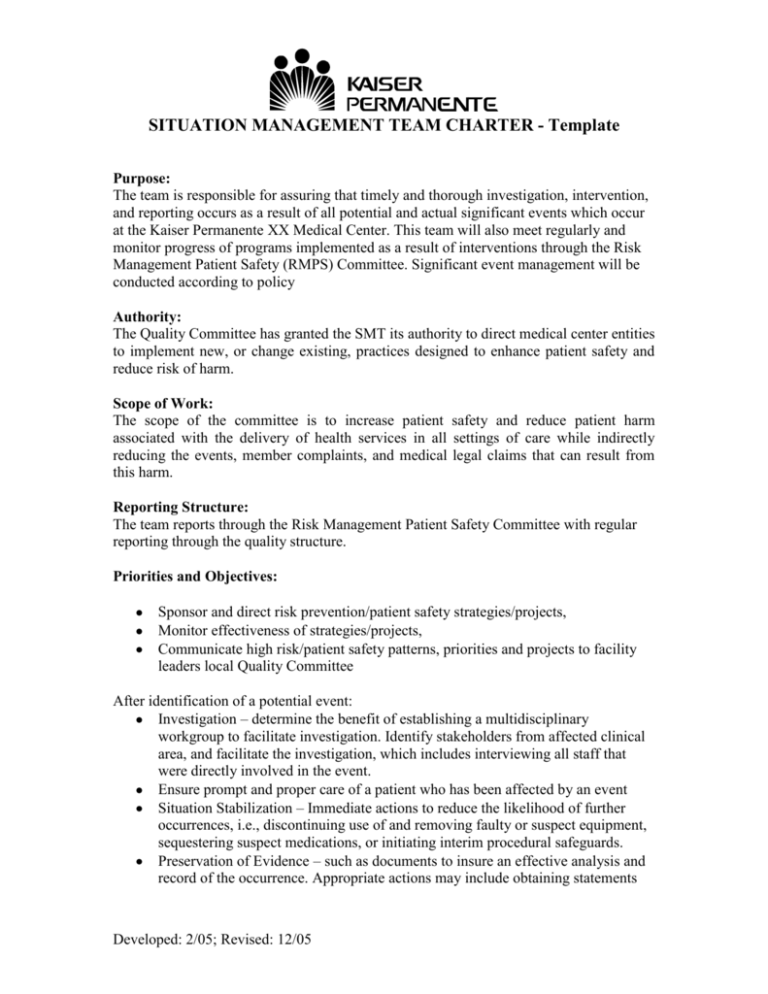
SITUATION MANAGEMENT TEAM CHARTER - Template Purpose: The team is responsible for assuring that timely and thorough investigation, intervention, and reporting occurs as a result of all potential and actual significant events which occur at the Kaiser Permanente XX Medical Center. This team will also meet regularly and monitor progress of programs implemented as a result of interventions through the Risk Management Patient Safety (RMPS) Committee. Significant event management will be conducted according to policy Authority: The Quality Committee has granted the SMT its authority to direct medical center entities to implement new, or change existing, practices designed to enhance patient safety and reduce risk of harm. Scope of Work: The scope of the committee is to increase patient safety and reduce patient harm associated with the delivery of health services in all settings of care while indirectly reducing the events, member complaints, and medical legal claims that can result from this harm. Reporting Structure: The team reports through the Risk Management Patient Safety Committee with regular reporting through the quality structure. Priorities and Objectives: Sponsor and direct risk prevention/patient safety strategies/projects, Monitor effectiveness of strategies/projects, Communicate high risk/patient safety patterns, priorities and projects to facility leaders local Quality Committee After identification of a potential event: Investigation – determine the benefit of establishing a multidisciplinary workgroup to facilitate investigation. Identify stakeholders from affected clinical area, and facilitate the investigation, which includes interviewing all staff that were directly involved in the event. Ensure prompt and proper care of a patient who has been affected by an event Situation Stabilization – Immediate actions to reduce the likelihood of further occurrences, i.e., discontinuing use of and removing faulty or suspect equipment, sequestering suspect medications, or initiating interim procedural safeguards. Preservation of Evidence – such as documents to insure an effective analysis and record of the occurrence. Appropriate actions may include obtaining statements Developed: 2/05; Revised: 12/05 SITUATION MANAGEMENT TEAM CHARTER - Template from witnesses, securing medical records and/or biological specimens, sequestering suspect medications and suspect medical equipment Assessment of need for additional follow-up actions with staff and practitioners including decisions for administrative leave pending investigation for errors that are caused by an employee under the influence of drugs or alcohol; has deliberately violated rules or regulations; specifically intended to cause harm; or engaged in gross or egregious conduct. Develop a chronology of relevant history Complete Event Investigation Worksheet Assist with Root Cause Analysis as appropriate Monitor interventions and plans of correction – periodically review the plans of correction and outcome measurements for significant events (through the RMPS Committee). Structure: Decisions to be made by consensus of at least a quorum of the membership A quorum is defined as one half of the membership Contemporaneous minutes to be taken. Frequency of meetings: The team will meet weekly. After-hours, in response to a potential or actual event, the Administrator On-Call is responsible for notifying members of the team. Annual Evaluation: Evaluation of structure/function of committee and sub-committees, including membership and charter Effectiveness of activities, projects, goals and priorities, as well as determination of barriers encountered, and the setting of goals and priorities for the following year. Confidentiality: All Situation Management Committee and subcommittee minutes, reports, recommendations, memoranda, and documented actions are considered quality assessment working documents and are kept confidential. They are maintained in accordance with policies and procedures, and are privileged and protected from discovery under statutes related to quality improvement/quality assessment and peer review. All records are maintained in a manner that preserves their integrity, in order to assure that patient and practitioner confidentiality is protected. All staff receive training on confidentiality at the time of hire and annually thereafter. Developed: 2/05; Revised: 12/05 SITUATION MANAGEMENT TEAM CHARTER - Template Membership: The team is co-chaired by Risk Physician leader and the Director of Risk Management/Patient Safety. Members: Chief Quality Officer Nurse Executive Quality Physician leader Chief Operating Officer Assistant Chief of Quality Medical/Legal Chief Assistant Medical Group Administrator Risk/Quality Director of Nursing Practice Ad Hoc members: Director of Quality Director of Member Services Director of AR&L Public Affairs Leader Health Care Ombuds/Mediator (HCOM) other individuals as dictated by case specifics. Developed: 2/05; Revised: 12/05 COMMUNICATING UNANTICIPATED ADVERSE OUTCOMES Situation Management Team Roles and Responsibilities ADVISE: To serve as a consultant to the clinicians, staff and administrators involved in an adverse outcome in order to help them identify and work through the key issues that these situations involve. COACH: To allow the opportunity to think through and practice responses to the patient and family in order to build and deliver a response consistent with our principles. This could include role-playing to get words, voice tone and body language that are appropriate to the disclosure situation at hand and that anticipate the turns and challenges that may emerge in the discussion. COUNSEL: To assist the clinicians, staff and administrators in the emotional distress that often accompanies these adverse outcomes and the disclosure situations. This may include arranging for most effective resources or providing the counseling itself to the extent one feels trained and able. FACILITATE: To attend the meetings among clinicians, staff and administrators and with patients and families to moderate the discussion, to assist in promoting an honest, empathic and sensitive discussion of the issues and to help set and enforce safe boundaries for the discussion for all parties involved. This will involve helping to set up pre-meeting ground rules as well as helping to guide the discussion as it actually takes place. COORDINATE: To recognize and follow-up on the tasks that emerge from disclosure situations and which may require involvement from multiple clinician, staff and administrative departments interacting with the patient and family over a longer period of time. SERVE AS OMBUDSPERSON: To be a person to whom anyone involved in the disclosure process can go to express concern and who will take responsibility to see that these concerns get acknowledged and addressed as the process goes forward. Ombudsperson intervenes early and resolves issues at the lowest level possible, involving the least number of individuals. COMMUNICATING UNANTICIPATED ADVERSE OUTCOMES Implementing the “Communicating Unanticipated Adverse Outcomes” Program —A Roadmap To Help Guide the SMT— 1. Program Purpose and Goals 2. Assessment of Current Process / Performance (Including Strengths and Gaps) 3. Key Players — Who’s going to get you there ? A. Program Sponsor(s)1 B. Program Champion(s)2 C. SMT Members D. SMT Partners E. Others: 1 Your sponsor should be able and willing to establish and communicate the context and rationale for your project, create commitment, allocate resources, participate in goal setting, monitor progress, and align reward and recognition systems 2 Your champion should be tenacious, credible, flexible, empowering, communicative, results-oriented, organized, and motivating. Of all these, credible may be the most important. 1 COMMUNICATING UNANTICIPATED ADVERSE OUTCOMES 4. Program Elements Requiring Planning A. B. C. D. E. F. G. H. Policy/Procedure Roles and Responsibilities Resource Planning Education and Training Reporting Process Response Mechanism Monitoring Function Organizational Learning and Sharing 5. How Will You Know You’re Succeeding? Developing A Local Measurement Strategy It may be helpful to think in terms of the following: What question are you Trying to answer? What is your source Of information? What measure will You use? What is the Frequency? 6. Anticipated Resource Needs and Issues (Time and Budget) 7. Communication Plan Target Audience Their Issues Our Message 2 Timing Messenger / Media COMMUNICATING UNANTICIPATED ADVERSE OUTCOMES 8. Project Plan – How are you going to get there from here? Action Responsible Party Completion Date Comments Critical Success Factors To Consider (from other KP initiatives). Which are your top 3-5? Get key stakeholders involved – Build Coalitions & Encourage Shared Ownership Sponsorship – Authorization, participation, celebration Champion – Don’t leave home without one Budget Time; Budget Money Position as a Supplement; Not a Replacement Align with other organizational priorities and get key stakeholders aligned Answer the value proposition question – WIIFM (What’s In It For Me)? Test small before going big Develop stories and data; share successes and learn from mistakes Network with your colleagues Persistence and patience pays off Other: Implementation Elements (3-6 month horizon) Attend SMT Training Draft project workplan Build Leadership’s Awareness & Create Buy-in Identify Potential Target Areas for early program implementation and testing Recruit sponsors, champions, and other team members Develop partners Identify resource needs Procure funding Define R&R and Develop written policy / procedure as appropriate Plan Training and Education program 3 Develop measurement strategy Formalize a communication plan Schedule physician workshops Monitor progress and Debrief incidents Provide follow-up consultation / training as necessary Report learnings and develop longer-term plan COMMUNICATING UNANTICIPATED ADVERSE OUTCOMES Some Questions That May Facilitate Your Planning Discussions How does our current process of communicating to patients and their families after an unanticipated adverse outcome work? What might be different with the approach we’ve been discussing in this meeting and our current process? What do we need from sponsorship? Who will champion this initiative? Who are our key partners and how do we get them involved? What will the impact be on staffing, if any, and do key players have the right skills? What is our local monitoring strategy going to be? How should we prioritize roll-out? What do we need to budget for now? How is this initiative connected to other initiatives / programs in our area? What do we need from the Program Office? What will trigger a report to the SMT and how will the SMT get that information? How will we convene the SMT, if necessary? Do we see the team getting together physically? What 3 - 5 things do we want all our physicians to know about this initiative? How will we train existing physicians and new hires? What about retraining? Record other key questions here. 4

